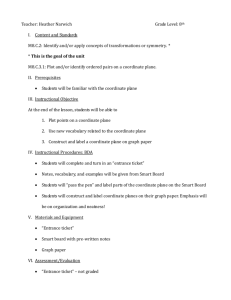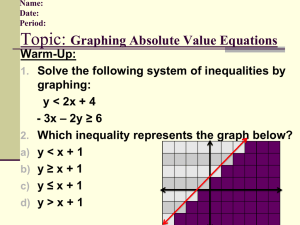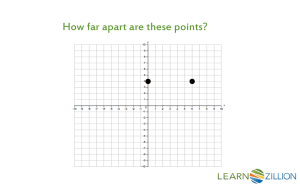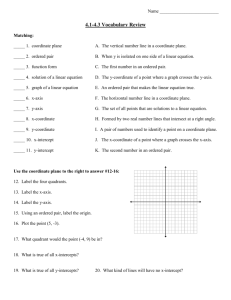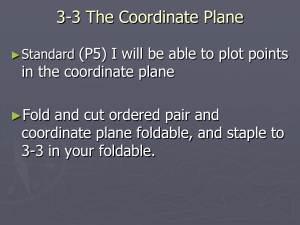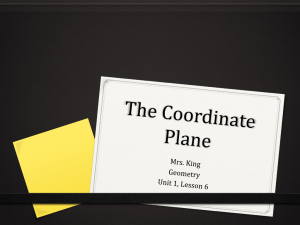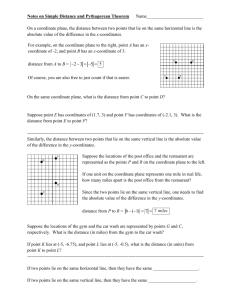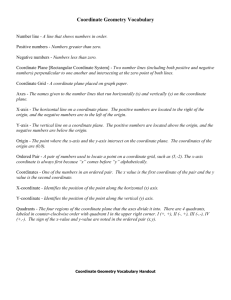Pre-Calculus
advertisement
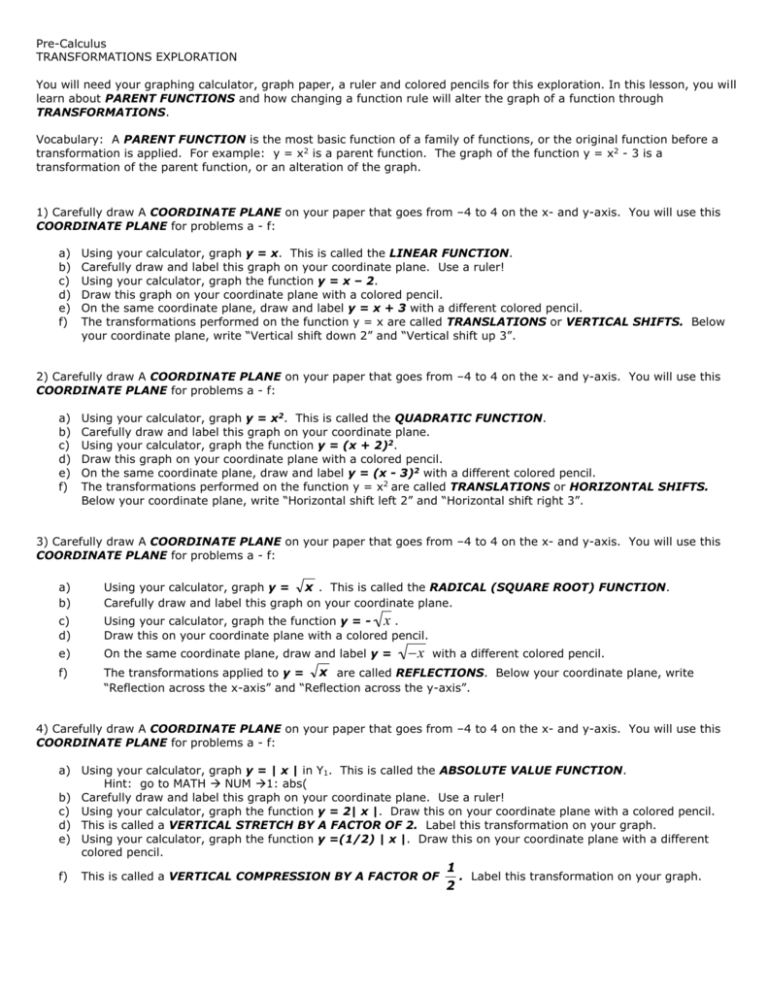
Pre-Calculus TRANSFORMATIONS EXPLORATION You will need your graphing calculator, graph paper, a ruler and colored pencils for this exploration. In this lesson, you will learn about PARENT FUNCTIONS and how changing a function rule will alter the graph of a function through TRANSFORMATIONS. Vocabulary: A PARENT FUNCTION is the most basic function of a family of functions, or the original function before a transformation is applied. For example: y = x2 is a parent function. The graph of the function y = x2 - 3 is a transformation of the parent function, or an alteration of the graph. 1) Carefully draw A COORDINATE PLANE on your paper that goes from –4 to 4 on the x- and y-axis. You will use this COORDINATE PLANE for problems a - f: a) b) c) d) e) f) Using your calculator, graph y = x. This is called the LINEAR FUNCTION. Carefully draw and label this graph on your coordinate plane. Use a ruler! Using your calculator, graph the function y = x – 2. Draw this graph on your coordinate plane with a colored pencil. On the same coordinate plane, draw and label y = x + 3 with a different colored pencil. The transformations performed on the function y = x are called TRANSLATIONS or VERTICAL SHIFTS. Below your coordinate plane, write “Vertical shift down 2” and “Vertical shift up 3”. 2) Carefully draw A COORDINATE PLANE on your paper that goes from –4 to 4 on the x- and y-axis. You will use this COORDINATE PLANE for problems a - f: a) b) c) d) e) f) Using your calculator, graph y = x2. This is called the QUADRATIC FUNCTION. Carefully draw and label this graph on your coordinate plane. Using your calculator, graph the function y = (x + 2)2. Draw this graph on your coordinate plane with a colored pencil. On the same coordinate plane, draw and label y = (x - 3)2 with a different colored pencil. The transformations performed on the function y = x2 are called TRANSLATIONS or HORIZONTAL SHIFTS. Below your coordinate plane, write “Horizontal shift left 2” and “Horizontal shift right 3”. 3) Carefully draw A COORDINATE PLANE on your paper that goes from –4 to 4 on the x- and y-axis. You will use this COORDINATE PLANE for problems a - f: a) b) Using your calculator, graph y = x . This is called the RADICAL (SQUARE ROOT) FUNCTION. Carefully draw and label this graph on your coordinate plane. c) d) Using your calculator, graph the function y = - x . Draw this on your coordinate plane with a colored pencil. e) On the same coordinate plane, draw and label y = f) The transformations applied to y = x are called REFLECTIONS. Below your coordinate plane, write “Reflection across the x-axis” and “Reflection across the y-axis”. x with a different colored pencil. 4) Carefully draw A COORDINATE PLANE on your paper that goes from –4 to 4 on the x- and y-axis. You will use this COORDINATE PLANE for problems a - f: a) Using your calculator, graph y = | x | in Y1. This is called the ABSOLUTE VALUE FUNCTION. Hint: go to MATH NUM 1: abs( b) Carefully draw and label this graph on your coordinate plane. Use a ruler! c) Using your calculator, graph the function y = 2| x |. Draw this on your coordinate plane with a colored pencil. d) This is called a VERTICAL STRETCH BY A FACTOR OF 2. Label this transformation on your graph. e) Using your calculator, graph the function y =(1/2) | x |. Draw this on your coordinate plane with a different colored pencil. f) This is called a VERTICAL COMPRESSION BY A FACTOR OF 1 . Label this transformation on your graph. 2 5) Carefully draw A COORDINATE PLANE on your engineering paper that goes from –4 to 4 on the x- and y-axis. You will use this COORDINATE PLANE for problems 25 - 28: a) Using your calculator, graph y = x3 in Y1. This is called the CUBIC FUNCTION. b) Carefully draw and label this graph on your coordinate plane. Use a ruler! 3 c) Using your calculator, graph y = (2x) . d) Carefully draw and label this graph on your coordinate plane. e) This is called a HORIZONTAL COMPRESSION BY A FACTOR OF Label this transformation on your graph. f) Using your calculator, graph y = 1 . Be careful! The factor is not 2, it is ½. 2 1 ( x) 3 . 2 g) Carefully draw and label this graph on your coordinate plane. h) This is called a HORIZONTAL STRETCH BY A FACTOR OF 2. Be careful! The factor is not 1/2, it is 2. Label this transformation on your graph. 6) Carefully draw A COORDINATE PLANE on your paper that goes from –4 to 4 on the x- and y-axis. You will use this COORDINATE PLANE for problems a - d: a) Using your calculator, graph y = 1 . This is called the RECIPROCAL (RATIONAL) FUNCTION. x b) Carefully draw and label this graph on your coordinate plane. Use a ruler! c) Think about it! What will happen if you graph y = 1 2 ? Graph, using a colored pencil, what you think ( x 3) this function will look like. Then, check it with your calculator. d) Label the combination of transformations that were applied. 7) ON A SEPARATE PAPER: For each of the following, identify the parent function and describe the transformations that have occurred to the parent function. a) y = 2(x 1) 2 b) y = ( x 4)3 c) y= x 3 d) y = 1 2 (x 1) e) y = x 3 2 f) y= 1 x 2 g) y = 2x h) y = 2 3 x i) y= (x 3)2 4 j) y= x 5 3 k) y= (x 2) 3 1 l) y= x3 2

